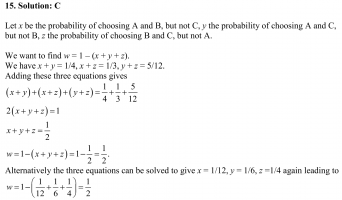An insurer offers a health plan to the employees of a large company. As part of this plan, the individual employees may choose exactly two of the supplementary coverages A, B, and C, or they may choose no supplementary coverage. The proportions of the company’s employees that choose coverages A, B, and C are 1/4, 1/3, and 5/12 respectively. Calculate the probability that a randomly chosen employee will choose no supplementary coverage.
(A) 0 (B) 47/144 (C) 1/2 (D) 97/144 (E) 7/9
So I understand that I want to find the three probabilities of A and B but not C; A and C but not B; B and C but not A, and then add these three things together and subtract from 1. Where I'm having trouble is how to find those probabilities. When I looked at the solution...
The solution given by the exam seems to imply that I should know the following:
P(A and B but not C) + P(A and C but not B) = P(A)
P(A and B but not C) + P(B and C but not A) = P(B)
P(A and C but not B) + P(B and C but not A) = P(C)
Can someone help me with why those three statements are true? I can follow the Algebra after this step, but I'm stuck here.

(A) 0 (B) 47/144 (C) 1/2 (D) 97/144 (E) 7/9
So I understand that I want to find the three probabilities of A and B but not C; A and C but not B; B and C but not A, and then add these three things together and subtract from 1. Where I'm having trouble is how to find those probabilities. When I looked at the solution...
The solution given by the exam seems to imply that I should know the following:
P(A and B but not C) + P(A and C but not B) = P(A)
P(A and B but not C) + P(B and C but not A) = P(B)
P(A and C but not B) + P(B and C but not A) = P(C)
Can someone help me with why those three statements are true? I can follow the Algebra after this step, but I'm stuck here.

Last edited:
